Papers by Francesca Grippa

Journal of information technology case and application research, Jul 1, 2010
Abstract This paper presents a framework developed to monitor the evolution of learning communiti... more Abstract This paper presents a framework developed to monitor the evolution of learning communities intended as open communities of peers, tutors, and mentors from industry and academia. The proposed framework is described through a case study that provides empirical evidence of the benefits of studying learning communities by observing group dynamics and detecting individual trends. It has been applied to observe and supervise a learning community built around a Master’s Program intended to create e-Business Solutions Engineers. The framework is based on two dimensions of analysis: the individual growth and the team growth. The first is function of personal development and satisfaction, while the second depends on social networking dynamics and cooperative content creation. The analysis of data, collected through ten months of exchanged e-mails and five monthly web-surveys, has been validated through interviews of the Program’s coordinator and the Program Director, as well as through the involvement of academic and industrial partners in the formal assessment of the learners ’performance.
Open Business Innovation Leadership, 2009
In the last three decades, the transformation processes experienced by industrialized countries r... more In the last three decades, the transformation processes experienced by industrialized countries radically changed the international economic and social structure. A relatively new approach to interpret and frame the meaning of these changes is provided by the neo-Schumpeterian analysis. This field of the economic literature investigates the dynamic processes of qualitative transformation of economies that are driven by the introduction of various forms of innovations. In particular, the neo-Schumpeterian view assumes the centrality of large technological innovations in determining the dynamics of economic and social systems, and offers tools for understanding long-term fluctuations (Dosi et al., 1988).
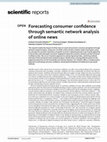
Scientific Reports, Jul 21, 2023
This research studies the impact of online news on social and economic consumer perceptions throu... more This research studies the impact of online news on social and economic consumer perceptions through semantic network analysis. Using over 1.8 million online articles on Italian media covering four years, we calculate the semantic importance of specific economic-related keywords to see if words appearing in the articles could anticipate consumers' judgments about the economic situation and the Consumer Confidence Index. We use an innovative approach to analyze big textual data, combining methods and tools of text mining and social network analysis. Results show a strong predictive power for the judgments about the current households and national situation. Our indicator offers a complementary approach to estimating consumer confidence, lessening the limitations of traditional survey-based methods. Monthly reports of the nation's level of consumer confidence can offer a first understanding of the consumers' sentiment and predict their spending. Consumer confidence has been traditionally associated with objective political and economic conditions and external factors like news media coverage. Indeed, previous research has shown that survey data, such as the Consumer Confidence Index (CCI), can successfully support the forecasting of economic variables released with a substantial delay e.g., 1-3. Survey data are often used as initial conditions for macroeconomic models or for modifying a baseline distribution to match certain moment conditions of interest given by the survey e.g., 4-6. Cascaldi-Garcia and colleagues 7 also showed that opinion surveys, such as the CCI, are particularly important for nowcasting economic variables released with a substantial delay and push forward the idea of predicting economic opinions surveys. However, despite the general attention given to consumer confidence surveys, their reliability in providing information about the future path of household spending is still not entirely explored 8. It has been demonstrated how the predictive power of consumer confidence surveys is influenced by factors including economic conditions, current and past political situations, trust in the government, and the influence of the news industry 9-11. The media, both mainstream and digital, can influence how consumers feel about the economy. Barsky and Sims 12 found that the relationship between consumer confidence and consequent activity is almost entirely reflective of the news component. In a series of studies on the role of media in influencing the stock market and the financial performance of companies, Tetlock 13,14 used a Bag-of-Words approach to quantify the language used in financial news stories and found that, contrary to popular belief, media pessimism weakly predicts increases in market volatility. In another study, Tetlock, Saar-Tsechansky and Macskassy 15 found that negative language used in financial press articles can predict low earnings for firms, suggesting that the words used in news stories are not superfluous information, but rather, they capture essential aspects of a company's fundamentals that are otherwise difficult to quantify. Li's study 16 on the usage of the terms "risk" and "uncertain" in a company's annual reports highlights the importance of paying attention to the language used in financial reports. By analyzing the words chosen by companies, investors can gain insight into the level of risk associated with the company's operations. Market prediction and consumer behavior mechanisms that rely on online text mining are only now beginning to be thoroughly investigated, thanks to the significant advancements in computational processing power and network speed in recent years 17. In our study, we adopt a Big Data methodology to forecast consumer confidence, looking at the role of online news and its influence on consumer confidence. We investigate how online news-as reported in digital newspapers and other online sources-influences consumer confidence
RePEc: Research Papers in Economics, May 1, 2021
This paper explores the association between brand importance and growth in museum visitors. We an... more This paper explores the association between brand importance and growth in museum visitors. We analyzed 10 years of online forum discussions and applied the Semantic Brand Score (SBS) to assess the brand importance of five European Museums. Our Naive Bayes and regression models indicate that variations in the combined dimensions of the SBS (prevalence, diversity and connectivity) are aligned with changes in museum visitors. Results suggest that, in order to attract more visitors, museum brand managers should focus on increasing the volume of online posting and the richness of information generated by users around the brand, rather than controlling for the posts' overall positivity or negativity.
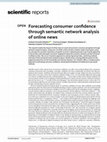
arXiv (Cornell University), May 11, 2021
This research studies the impact of online news on social and economic consumer perceptions throu... more This research studies the impact of online news on social and economic consumer perceptions through semantic network analysis. Using over 1.8 million online articles on Italian media covering four years, we calculate the semantic importance of specific economic-related keywords to see if words appearing in the articles could anticipate consumers' judgments about the economic situation and the Consumer Confidence Index. We use an innovative approach to analyze big textual data, combining methods and tools of text mining and social network analysis. Results show a strong predictive power for the judgments about the current households and national situation. Our indicator offers a complementary approach to estimating consumer confidence, lessening the limitations of traditional survey-based methods. Monthly reports of the nation's level of consumer confidence can offer a first understanding of the consumers' sentiment and predict their spending. Consumer confidence has been traditionally associated with objective political and economic conditions and external factors like news media coverage. Indeed, previous research has shown that survey data, such as the Consumer Confidence Index (CCI), can successfully support the forecasting of economic variables released with a substantial delay e.g., 1-3. Survey data are often used as initial conditions for macroeconomic models or for modifying a baseline distribution to match certain moment conditions of interest given by the survey e.g., 4-6. Cascaldi-Garcia and colleagues 7 also showed that opinion surveys, such as the CCI, are particularly important for nowcasting economic variables released with a substantial delay and push forward the idea of predicting economic opinions surveys. However, despite the general attention given to consumer confidence surveys, their reliability in providing information about the future path of household spending is still not entirely explored 8. It has been demonstrated how the predictive power of consumer confidence surveys is influenced by factors including economic conditions, current and past political situations, trust in the government, and the influence of the news industry 9-11. The media, both mainstream and digital, can influence how consumers feel about the economy. Barsky and Sims 12 found that the relationship between consumer confidence and consequent activity is almost entirely reflective of the news component. In a series of studies on the role of media in influencing the stock market and the financial performance of companies, Tetlock 13,14 used a Bag-of-Words approach to quantify the language used in financial news stories and found that, contrary to popular belief, media pessimism weakly predicts increases in market volatility. In another study, Tetlock, Saar-Tsechansky and Macskassy 15 found that negative language used in financial press articles can predict low earnings for firms, suggesting that the words used in news stories are not superfluous information, but rather, they capture essential aspects of a company's fundamentals that are otherwise difficult to quantify. Li's study 16 on the usage of the terms "risk" and "uncertain" in a company's annual reports highlights the importance of paying attention to the language used in financial reports. By analyzing the words chosen by companies, investors can gain insight into the level of risk associated with the company's operations. Market prediction and consumer behavior mechanisms that rely on online text mining are only now beginning to be thoroughly investigated, thanks to the significant advancements in computational processing power and network speed in recent years 17. In our study, we adopt a Big Data methodology to forecast consumer confidence, looking at the role of online news and its influence on consumer confidence. We investigate how online news-as reported in digital newspapers and other online sources-influences consumer confidence
International Journal of Innovation and Technology Management, 2012
This paper describes the benefits of applying a Social Network Dashboard to monitor the evolution... more This paper describes the benefits of applying a Social Network Dashboard to monitor the evolution of knowledge flows within communities of innovation. Social interactions are observed within and across four inter-organizational communities at a large aerospace company. The application of the Dashboard revealed which of the communities were characterized by a more intense and active knowledge flow and a less centralized communication pattern. These communities were the most outwardly connected and the most productive in terms of financial outcomes. This study provides empirical evidence of the importance of using a network approach as a complementary method to monitor communities' evolution.

Journal of Knowledge Management
Purpose This study aims to investigate the dynamics of knowledge sharing in health care, explorin... more Purpose This study aims to investigate the dynamics of knowledge sharing in health care, exploring some of the factors that are more likely to influence the evolution of idea sharing and advice seeking in health care. Design/methodology/approach The authors engaged 50 pediatricians representing many subspecialties at a mid-size US children’s hospital using a social network survey to map and measure advice seeking and idea sharing networks. Through the application of Stochastic Actor-Oriented Models, the authors compared the structure of the two networks prior to a leadership program and eight weeks post conclusion. Findings The models indicate that health-care professionals carefully and intentionally choose with whom they share ideas and from whom to seek advice. The process is fluid, non-hierarchical and open to changing partners. Significant transitivity effects indicate that the processes of knowledge sharing can be supported by mediation and brokerage. Originality/value Hospita...
Digital Transformation of Collaboration, 2020
We describe a preliminary experiment to track the emotions of actors and audience in a theater pl... more We describe a preliminary experiment to track the emotions of actors and audience in a theater play through machine learning and AI. During a forty-minute play in Zurich, eight actors were equipped with body sensing smartwatches. At the same time, the emotions of the audience were tracked anonymously using facial emotion tracking. In parallel, also the emotions in the voices of the actors were assessed through automatic voice emotion tracking. This paper demonstrates a first fully automated and privacy-respecting system to measure both audience and actor satisfaction during a public performance.
Tourism Management Perspectives, 2020
This paper explores the association between brand importance and growth in museum visitors. We an... more This paper explores the association between brand importance and growth in museum visitors. We analyzed 10 years of online forum discussions and applied the Semantic Brand Score (SBS) to assess the brand importance of five European Museums. Our Naive Bayes and regression models indicate that variations in the combined dimensions of the SBS (prevalence, diversity and connectivity) are aligned with changes in museum visitors. Results suggest that, in order to attract more visitors, museum brand managers should focus on increasing the volume of online posting and the richness of information generated by users around the brand, rather than controlling for the posts' overall positivity or negativity.
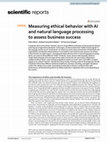
Scientific Reports
Everybody claims to be ethical. However, there is a huge difference between declaring ethical beh... more Everybody claims to be ethical. However, there is a huge difference between declaring ethical behavior and living up to high ethical standards. In this paper, we demonstrate that “hidden honest signals” in the language and the use of “small words” can show true moral values and behavior of individuals and organizations and that this ethical behavior is correlated to real-world success; however not always in the direction we might expect. Leveraging the latest advances of AI in natural language processing (NLP), we construct three different “tribes” of ethical, moral, and non-ethical people, based on Twitter feeds of people of known high and low ethics and morals: fair and modest collaborators codified as ethical “bees”; hard-working competitive workers as moral “ants”; and selfish, arrogant people as non-ethical “leeches”. Results from three studies involving a total of 49 workgroups and 281 individuals within three different industries (healthcare, business consulting, and higher e...
Studies on Entrepreneurship, Structural Change and Industrial Dynamics, 2018
This case study illustrates the growth process of a collaborative innovation network in healthcar... more This case study illustrates the growth process of a collaborative innovation network in healthcare. It tracks e-mail communication of COIN members through a method we call "virtual mirroring", and measures the online perception of the topics of the COIN by coolhunting on social media such as Twitter and blogs. It also describes how the COIN members through "coolfarming" self-organize and identify new sub-topics for their work. In particular, the paper describes the growth process of the
Sustainability, 2021
The authors would like to make the following corrections about the published paper [...]
Sustainability, 2021
The authors would like to make the following corrections about the published paper [...]
Fronzetti Colladon, A., Gloor, P. A., & Grippa, F. (2017). Communicate or Perish. Predict... more Fronzetti Colladon, A., Gloor, P. A., & Grippa, F. (2017). Communicate or Perish. Predicting innovative behaviors via Email Communication Analysis. Abstract presented at the XXXVII Sunbelt Conference of the International Network for Social Network Analysis. Beijing, China.
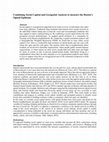
Social support is considered an important factor in the recovery of individuals, who suffer from ... more Social support is considered an important factor in the recovery of individuals, who suffer from drug use disorder. Traditional drug treatment interventions have mainly focused on the individual without taking into consideration the social and environmental conditions that may support or reduce drug use. By combining a social capital framework with geospatial research methodologies, we mapped hot spots and cold spots within the 23 Boston neighborhoods and identified where social ties were stronger or weaker. The spatial correlation analysis and Geographically Weighted Regression demonstrated that in areas where social capital is low, there is a moderately high incidence of opioid deaths and sick assist calls. Our analysis shows that in neighborhoods where residents are involved in charitable organizations, where people gather around religious organizations, or where unions are more active, people help each other more and might be aware of actions to take to prevent opioid-related de...
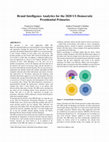
We describe a new web application (SBS BI, https://bi.semanticbrandscore.com) designed to assess ... more We describe a new web application (SBS BI, https://bi.semanticbrandscore.com) designed to assess brand image and importance through the analysis of textual data. The App calculates the Semantic Brand Score (SBS) [1] as its main measure. It also contains modules to fetch online news and tweets. The fetching modules use the Twitter API and the Event Registry API [2] in order to collect data. In addition, a dedicated option gives users the opportunity to connect to the Telpress platform, for the collection of news. After uploading a csv file, users can set a number of parameters, such as the language and time intervals of the analysis, the word co-occurrence range, and the minimum cooccurrence threshold for network filtering. The last step consists of running the core module, which will calculate and display the SBS composite indicator and its three dimensions: prevalence, diversity and connectivity [1]. Prevalence represents the frequency with which the brand name appears in a set of ...
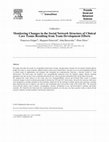
This paper describes the results of a longitudinal observation of team communication structure fo... more This paper describes the results of a longitudinal observation of team communication structure for two distinct interdisciplinary health care teams at a large academic children medical center in the United States. Our goal was to use the longitudinal analyses to inform teams of opportunities and strategies that strengthen the communication structures a function critical to team effectiveness. For both teams, the members were geographically dispersed across the hospital campus, thereby requiring dependence not only on face to face communication but also on e-mail to promote information flow and facilitate discussion. We analyzed the email archives of two teams (the Liver Transplant/Biliary Atresia and Cerebral Palsy teams) to monitor structural changes in email communication patterns between the 2010 and 2011 observations. Since the first analyses, both teams were designated as strategic priorities by the institution, underwent off site meetings to define and put into execution a str...











Uploads
Papers by Francesca Grippa